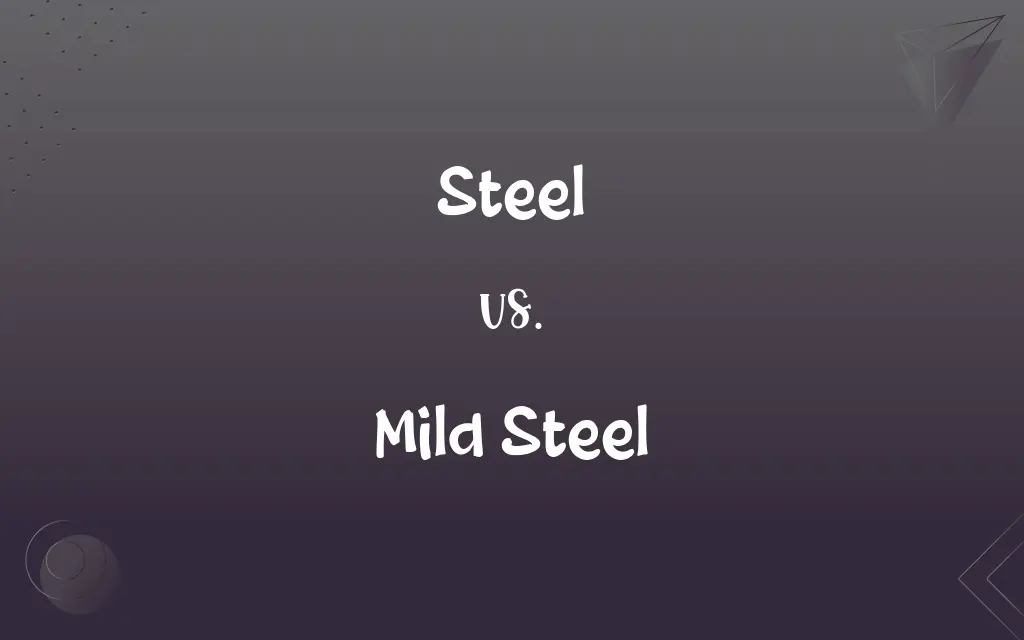Steel vs. Mild Steel: What's the Difference?
Edited by Aimie Carlson || By Harlon Moss || Published on November 29, 2023
Steel is an alloy primarily of iron and carbon; mild steel, a type of steel, contains a low amount of carbon, making it more ductile.

Key Differences
Steel is a versatile alloy mainly composed of iron with varying amounts of carbon and other elements. Mild steel, specifically, contains a lower carbon content, typically up to 0.25%, distinguishing it from other steel types.
While steel's properties can change based on its carbon content and additional alloying elements, mild steel, due to its lower carbon content, is more malleable and ductile. It's less brittle than high-carbon steels.
Steel's applications are vast, spanning from construction to automotive industries. Mild steel, with its superior weldability and ductility, is often used in structural applications, automotive body parts, and pipework.
Producing steel involves various processes, from blast furnaces to electric arc furnaces. Mild steel, being a basic form of carbon steel, is often less expensive to produce and buy compared to specialized steel alloys.
Steel's durability depends on its composition. Mild steel, without treatments or coatings, is more prone to corrosion compared to some other steel types due to its low carbon content.
ADVERTISEMENT
Comparison Chart
Composition
Alloy of iron, carbon, and other elements.
Iron alloy with typically up to 0.25% carbon.
Ductility
Varies based on carbon content.
More ductile due to low carbon content.
Applications
Vast, including construction, tools, and machinery.
Structural applications, pipework, auto body parts.
Corrosion Resistance
Depends on alloying elements and coatings.
Generally more prone to corrosion.
Cost
Varies based on type and alloying elements.
Typically less expensive than specialized steel types.
ADVERTISEMENT
Steel and Mild Steel Definitions
Steel
An alloy of iron with small amounts of carbon and possibly other elements.
Skyscrapers are often constructed using reinforced steel for added strength.
Mild Steel
A basic form of carbon steel, often less prone to brittleness.
The artist chose mild steel for his sculpture, valuing its workability.
Steel
An iron-based substance with properties influenced by carbon content.
High-carbon steel is often used for making cutting tools.
Mild Steel
A type of steel with low carbon content.
Mild steel is commonly used in automobile chassis.
Steel
A metal known for its strength and versatility in various applications.
Manufacturers prefer steel for creating durable tools.
Mild Steel
A more malleable and ductile form of steel.
Mild steel sheets are often formed into car body panels.
Steel
A prevalent metal alloy, pivotal in modern infrastructure and tools.
The steel industry significantly impacts the global economy.
Mild Steel
Carbon steel primarily characterized by its low carbon percentage.
Mild steel pipes are widely used in plumbing systems.
Steel
A hard, strong material used in construction and manufacturing.
The bridge's steel beams ensure its stability and longevity.
Mild Steel
Steel variant known for its superior weldability.
Builders prefer mild steel for constructing building skeletons.
Steel
A generally hard, strong, durable, malleable alloy of iron and carbon, usually containing between 0.2 and 1.5 percent carbon, often with other constituents such as manganese, chromium, nickel, molybdenum, copper, tungsten, cobalt, or silicon, depending on the desired alloy properties, and widely used as a structural material.
Steel
Something, such as a sword, that is made of steel.
FAQs
What's the primary difference between steel and mild steel?
Steel is a broad category of iron alloy, while mild steel is a type of steel with low carbon content.
Can mild steel resist corrosion effectively?
Mild steel is generally more susceptible to corrosion unless treated or coated.
Is stainless steel the same as mild steel?
No, stainless steel contains chromium and is corrosion-resistant, while mild steel doesn't have chromium and can rust.
Why is mild steel called "mild"?
It's called "mild" due to its low carbon content, which makes it softer and more malleable.
Can mild steel be hardened?
Mild steel can be hardened to a degree through heat treatments but not as effectively as high-carbon steels.
Is mild steel suitable for high-temperature applications?
It has a lower melting point than some other steels, so it may not be ideal for very high temperatures.
Can steel's properties be altered?
Yes, through heat treatments and adding different alloying elements, its properties can change.
Why is steel recycled often?
Steel retains its properties when recycled, making it sustainable and reducing the need for raw iron ore.
Are steel and mild steel both magnetic?
Generally, both steel and mild steel are magnetic, though some steel alloys may not be.
How does carbon content influence steel's characteristics?
Higher carbon increases hardness and strength but reduces ductility; lower carbon, as in mild steel, makes it more malleable.
Are steel and mild steel the same in strength?
Steel's strength varies based on its composition; mild steel is not as hard as high-carbon steels but is more ductile.
What's the carbon content in mild steel?
It typically contains up to 0.25% carbon.
How does the production process of steel and mild steel differ?
The basic production process is similar, but alloying elements and carbon content differentiate them.
In which industries is mild steel predominantly used?
It's widely used in construction, automotive, and manufacturing sectors.
Which is more expensive, steel or mild steel?
Prices vary, but mild steel is typically less expensive than specialized steel alloys.
Why is steel alloyed with other elements?
Alloying can enhance specific properties like strength, ductility, or corrosion resistance.
Are there types of steel other than mild steel?
Yes, there are various types like stainless steel, high-carbon steel, and tool steel, among others.
Does welding mild steel require special equipment?
Mild steel's superior weldability means it can be welded using standard equipment, though specifics may vary based on the application.
How do coatings protect mild steel from corrosion?
Coatings, like paint or zinc, act as barriers, preventing environmental factors from directly contacting the steel.
Why is mild steel popular in construction?
Its ductility and weldability make it suitable for many structural applications.
About Author
Written by
Harlon MossHarlon is a seasoned quality moderator and accomplished content writer for Difference Wiki. An alumnus of the prestigious University of California, he earned his degree in Computer Science. Leveraging his academic background, Harlon brings a meticulous and informed perspective to his work, ensuring content accuracy and excellence.
Edited by
Aimie CarlsonAimie Carlson, holding a master's degree in English literature, is a fervent English language enthusiast. She lends her writing talents to Difference Wiki, a prominent website that specializes in comparisons, offering readers insightful analyses that both captivate and inform.







































































